Thousands in Mexico’s cities protest ‘Plan B’ election reform February 27, 2023
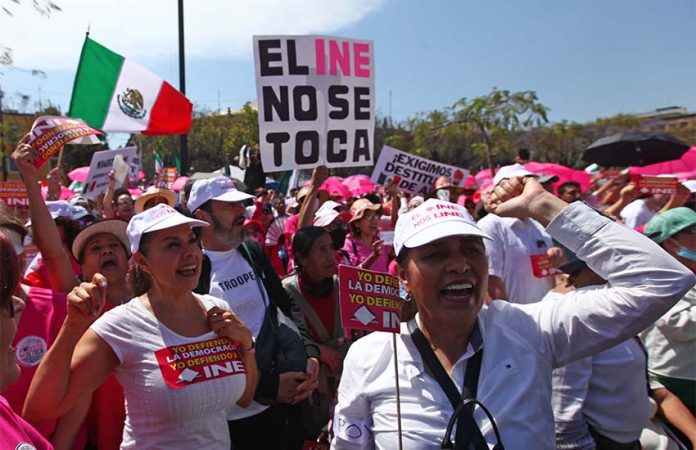
Hundreds of thousands of people took to the streets across Mexico on Sunday to protest the federal government’s recently-approved “Plan B” electoral reform laws and to demonstrate their support for the National Electoral Institute (INE), a key pillar of the country’s democracy.
Organized under the slogans and hashtags #ElINENoSeToca (Don’t Touch the INE) and #MiVotoNeSeToca (Don’t Touch My Vote), demonstrations took place in more than 100 cities including Mexico City; Guadalajara; Monterrey; León, Guanajuato; Culiacán, Sinaloa; Puebla; Toluca; Querétaro; Mérida; and Torreón, Coahuila.
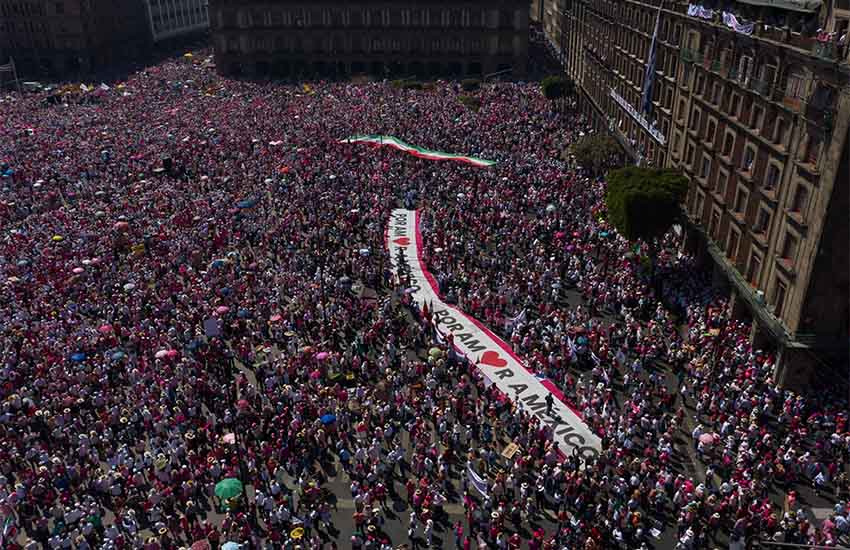
The protests came four days after the Senate approved the Plan B reform backed by President López Obrador, legislation that critics say will significantly weaken the INE and thus pose a threat to upcoming elections.
The reform — put forward after a more ambitious constitutional bill to overhaul Mexico’s electoral system was blocked in the legislature late last year — will slash INE’s budget and therefore force the dismissal of large numbers of staff, diminish its capacity to sanction politicians who violate electoral laws, curtail its autonomy and close some INE offices, among other consequences.
The INE is an autonomous elections oversight body that organizes elections at all three levels of government in Mexico.
Dressed in the INE’s logo’s colors of pink and white, protesters in Mexico City marched from various starting points to the capital’s central square, the Zócalo, located opposite the National Palace, the seat of executive power and López Obrador’s residence.
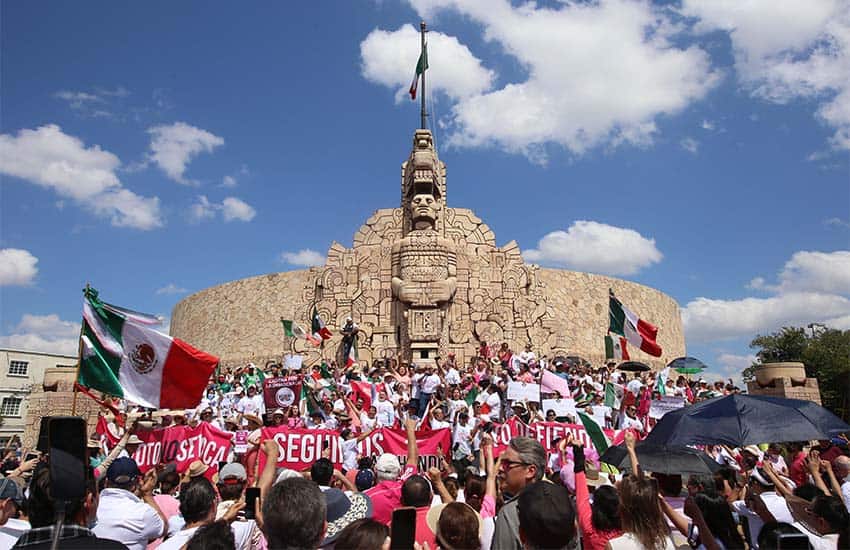
The Mexico City government said that 90,000 people participated in the demonstration, while organizers claimed that close to half a million citizens took to the capital’s streets to defend the INE and demand that the Supreme Court strike down what they see as an illegal reform and a threat to democracy in Mexico.
“We came to knock on the doors of the court … [to ask] the justices to not allow the loss of the nation and to say to them respectfully but with complete firmness, ‘Send Plan B to the dustbin of history; don’t endorse an unconstitutional and immoral electoral reform,’” said journalist and former federal deputy Beatriz Pagés in an address to protesters in the Zócalo.
“… They’re seeking to eliminate the [electoral] umpire to twist the decision of citizens [at the presidential election] in 2024,” said the spokesperson for Unid@s, a collective of citizens’ groups.
“The Plan B electoral reform is a fraud foretold. … If we let them steal our votes, later we’ll let them steal other rights and other freedoms,” Pagés said.
Former Supreme Court justice José Ramón Cossío Díaz expressed confidence that the nation’s highest court will invalidate the reform despite “the pressures” the 11 justices are under from “those seeking to take control of” Mexico’s electoral system.
“I’m sure that the justices … will declare that electoral norms that reduce the human and budgetary resources of electoral bodies violate the principles of equity and certainty,” he told protesters in the Zócalo.
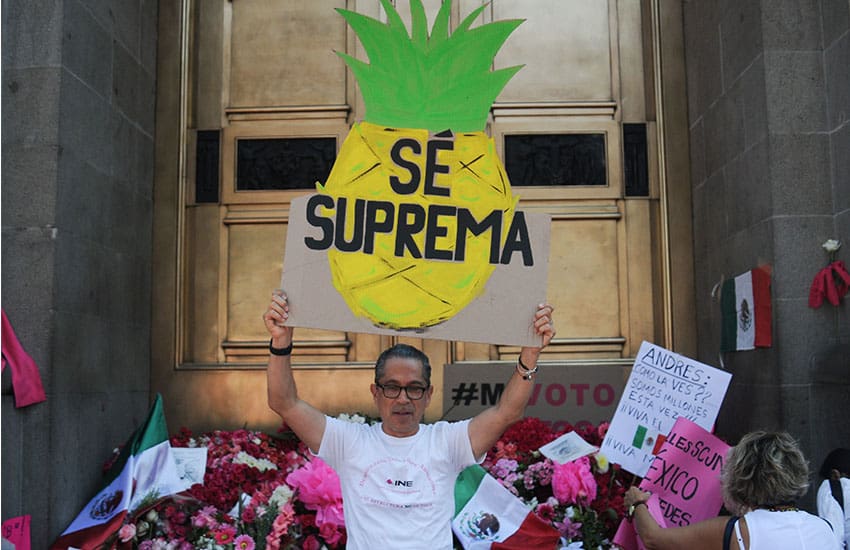
Opposition parties have indicated they will launch legal challenges to the reform once it has been promulgated via publication in the government’s official gazette.
Retiree Alejandra Orduña, who participated in the Mexico City protest, told the newspaper El País that López Obrador’s aim in putting forward the electoral reform was to ensure that the ruling Morena party stays in power after the 2024 election, at which a new president will be elected and both houses of Congress will be renewed.
“The INE is an autonomous institution that has guaranteed clean elections up until today. This man governing [now] arrived [to power] thanks to the INE, and now he wants to get rid of it and impose rules to perpetuate himself in power along with his followers,” Orduña said.
A couple in their fifties who spoke with El País agreed that “the INE is under threat” due to the approval of the Plan B reform, which, according to the government, could generate annual savings of as much as 5 billion pesos (US $271 million).
The couple, who told El Pais their names were Verónica and José Luis, said they were afraid that López Obrador would continue concentrating power in the executive — an accusation he has faced on numerous occasions since taking office in 2018.
Magdalena Rodríguez, a 70-year-old protester, told El País that she had never been involved in politics but decided to join the demonstration on Sunday because Mexico is in “complete decline” under the rule of the current government.
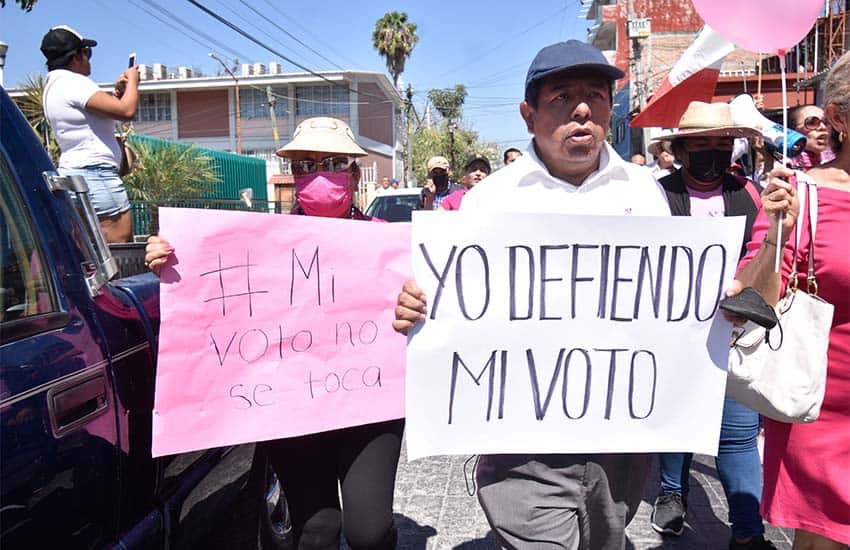
“We don’t want to get to communism. [López Obrador] thinks he’s God, but he’s not. He’s not the owner of the country either,” she said.
In Toluca, the newspaper Reforma reported, protesters chanted, “If the INE disappears, the dictatorship appears” and held up signs with the message: “We’re Plan C: constitution, court, citizens.”
The INE’s predecessor, the Federal Electoral Institute (IFE), oversaw Mexico’s transition to full democracy after the country was ruled without interruption by the Institutional Revolutionary Party (PRI) for over 70 years until the National Action Party triumphed at the 2000 presidential election.
Poll results published by the Reforma newspaper last November showed that 80% of respondents believe that the INE has played an important role in guaranteeing democracy in Mexico while 71% said that its demise would pose a threat to democracy.
The United States government has been urged by some U.S. newspapers such as The Washington Post to express its opposition to López Obrador’s “remaking” of the electoral system, and on Twitter on Sunday, U.S. Assistant Secretary of State for Western Hemisphere affairs Brian A. Nichols did that in a way, writing that “today, in Mexico, we see a great debate on electoral reforms that are testing the independence of electoral and judicial institutions.”
“The United States supports independent, well-resourced electoral institutions that strengthen democratic processes and the rule of law,” Nichols added.
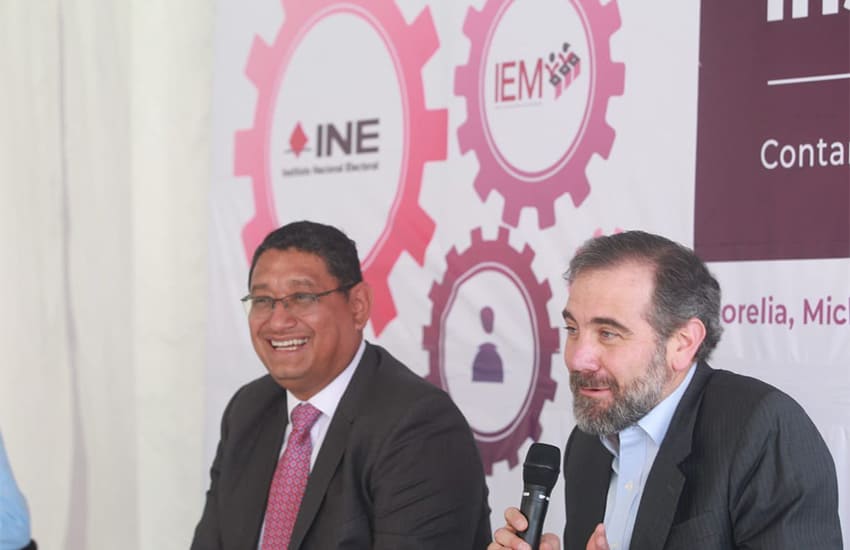
For his part, INE president Lorenzo Córdova — a tireless defender of the institute he heads — posted a photo of a packed Zócalo to his Twitter account on Sunday.
“Today I won’t publish my Sunday video,” he wrote. Today is a day of the citizenry, and it’s up to all of us to listen to them.”
The protests, which attracted a more middle and upper-class demographic than many other demonstrations, came three and a half months after Mexicans took to the streets in some 50 cities to defend the INE against the (ultimately defeated) plan to replace it and state-based electoral authorities with one centralized body.
According to an Associated Press report, many demonstrators were “simply wary of the kind of vote miscounting, campaign overspending and electoral pressure tactics that were common in Mexico before the independent electoral agency was created in the 1990s.”
While the Mexico City demonstration was easily the largest in the country, the protests in Guadalajara, Monterrey and León also attracted tens of thousands of people.
However, López Obrador, who remains a popular president, described the gatherings as “very small” given that “there must be about 25 million conservative citizens” in Mexico.
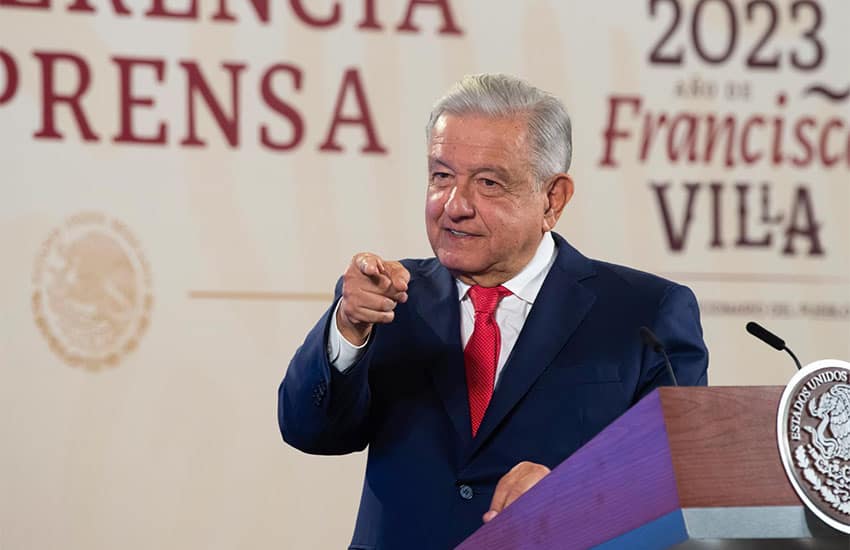
“… When they say ‘don’t touch the INE,’ what they’re thinking is don’t touch corruption, don’t touch privileges, don’t touch the narco state,” he said Monday while acknowledging that citizens “have every right to demonstrate.”
The president — who has rejected claims that the electoral reform places the staging of free and fair elections at risk while touting the billions of pesos in annual savings it will generate — also took aim at the two orators who addressed the protesters in the Zócalo.
“Beatriz Pagés, daughter of [deceased journalist] José Pagés Llergo from [the magazine] Siempre!, is very priista, very conservative,” López Obrador said, using a word for members and supporters of the once omnipotent PRI.
“And José Ramón Cossío is a fraud, … a Supreme Court justice during a narco state supported by [former president Felipe] Calderón,” he added, making hay out of the conviction in the United States last week of Calderon’s former security minister Genaro García Luna on drug trafficking charges.
With reports from El Economista, Reforma, El Universal, El País, Aristegui Noticias and Proceso
Tohcok, ‘the place of the precious flint knife’
ByCarlos Rosado van der Gracht
Every once in a while I am surprised to learn that an area I have driven by dozens of times is actually home to an archaeological site I had no idea was there.

This was the case a couple of weekends ago when my friend Roque and I found out about the existence of a recently restored site just a few kilometers from Hopelchén, Campeche.
There are literally thousands of archaeological sites of varying sizes dotting the Yucatán Peninsula, several being very hard to get to, but as it happens Tohcok lay right on the side of the highway.

Now, I could be forgiven for never having noticed Tohcok before as the area’s lush vegetation completely shrouded the ancient city until very recently.
Tohcok, also known as Tacó, was first uncovered in 1845 during the construction of a nearby hacienda. The site was likely plundered for construction materials, as was common in the past, but was otherwise mostly ignored for another century.

In 1951, Tohcok was rediscovered and documented by Edwin Shook and the Russian-born Tatiana Proskouriakoff, one of the first and greatest women in Mesoamerican archaeology.
In the Yucatec-Maya language, Tohcok roughly translates as “the place of the precious flint knife.”

Like many Puuc sites in the region, Tohcok was likely founded sometime between the 1st and 3rd century CE, but saw its zenith around the 8th or 9th.
The site was actually cleared and opened to the public briefly in 2019, but was shut down until last December, due to the “unpleasantness.”
But to say that Tohcok lay just to the side of the highway may actually not be technically correct, as the road from Hopelchén to the city of Campeche seems to actually bisect the site.
This idea is supported by the fact that the mounds of several structures can be seen to the west of the highway.

Just like Chunhuhub, which we covered last week, Tohcok rarely receives visitors. Indeed, the INAH guard seemed genuinely excited to see other people to show around the site.

The remains of Tohcok’s restored main plaza are framed by a once multi-level Puuc palatial structure, a vaulted architectural complex simply called Structure II, and an extremely ornate ceremonial platform.

Though Tohcok certainly bears many of the tell-tale markings of a Puuc city, elements of Chenes style architecture can also easily be seen in much of its decorative elements.
Structure II is notable for its several corbel-arched paths and niches, which were likely used for ritual purposes.

Despite its relatively small size, one of the most remarkable structures found in Tohcok is a ceremonial platform sporting several Chaac rain god masks along its base.

Another of Tohcok’s most notable features is the remains of murals likely dating to the 9th century CE.
During my research, I came across an article describing the scene of Tohcok’s murals in great detail. It seems clear that for some reason, likely conservation, most of the mural has been removed, as the section still visible at the site is of only one panel.

If you go
Getting to Tohcok is fairly easy from both Campeche and Mérida, as the roads are quite good. That being said there is no signage leading to the site up until you are virtually on top of it, so a navigation app such as Google maps is likely to come in handy.

If you are traveling from Mérida, the best route is to pass by Uxmal and Santa Elena, taking the old highway to Campeche. You will also pass the exit to Santa Rosa Xtampak, which is very much also worth a visit, though the final 15 or so miles to the site can be extremely rough unless you have a 4×4 ?— especially during the rainy season.

Entrance to Tohcok is free and as with all INAH archaeological sites is open from 8 a.m. to 4 p.m. daily.

Progreso’s Carnaval is giving Merida’s a run for its money ByCarlos Rosado van der Gracht

2023 turned out to be a huge year for Carnaval in Yucatán.
But with more cities and towns throwing their own festivities, Mérida’s Carnaval at the remote Xmatkuil fairgrounds is no longer the undisputed champion.

One of the biggest Carnaval upstarts is Progreso which, although not exactly new on the scene, has really upped its game with bigger and better parades, and huge concerts, with the advantage of a beach setting.

Aside from the beautiful setting, one of the reasons many folks are beginning to flock to Progreso’s Carnaval has to do with accessibility. For starters, the Mérida-Progreso highway is more than adequate, and buses out to the beach are plentiful. And for those in Mérida’s growing north, Progreso is much closer than Xmatkuil.

But with the growth of Progreso’s Carnaval, its laidback atmosphere has taken a hit, especially during Sunday’s parade.

Fortunately, to enjoy the parade without having to push through thousands of people, there is always Tuesday’s traditional “Paseo de las Flores,” which tends to kick off around noon.

The one major downside of Tuesday’s parade is the heat, and smart attendees brought along an umbrella and sunblock and drank plenty of water or coconut juice.

As is tradition, most of the floats threw candies, t-shirts, and hats to the roaring crowd. But unlike a generation ago, no cigarettes.

As is the case for carnavales in general, several of the floats featured young men and women in elaborate costumes featuring bright colors, enormous headdresses, and loads of feathers.

The LGBTQ+ community has long been a big part of Carnaval celebrations in Yucatán, and this year was no exception.

Both local and international brands had a strong presence at the parade, though some global brands’ participation felt uninspired.

Because Tuesday’s parade fell on a cruise day, more American tourists than average could be seen enjoying the parade.

This being Carnaval, a good deal of libations were consumed by attendees in some rather unorthodox costumes.

Local celebrities were also a fixture on several floats, including the well-loved comedian Ruperta Pérez Sosa.

Progreso’s Carnaval, with its parades, concerts, comedy shows, and other events, was a success and firmly cemented it as one of Yucatán’s best, if not the best overall.

Still, many in Mérida look back fondly on the days when the city Carnaval was held on Paseo de Montejo, though others just shrug and say “good riddance.”

Senate approves ‘Plan B’ electoral reform weakening the INE

- The Senate on Wednesday approved a major electoral reform package proposed by President López Obrador, legislation that critics say will significantly weaken the National Electoral Institute (INE) and thus pose a threat to upcoming elections.
A second part of the so-called “Plan B” reform will now be promulgated by López Obrador, who has been highly critical of the electoral institute and its president, Lorenzo Córdova.
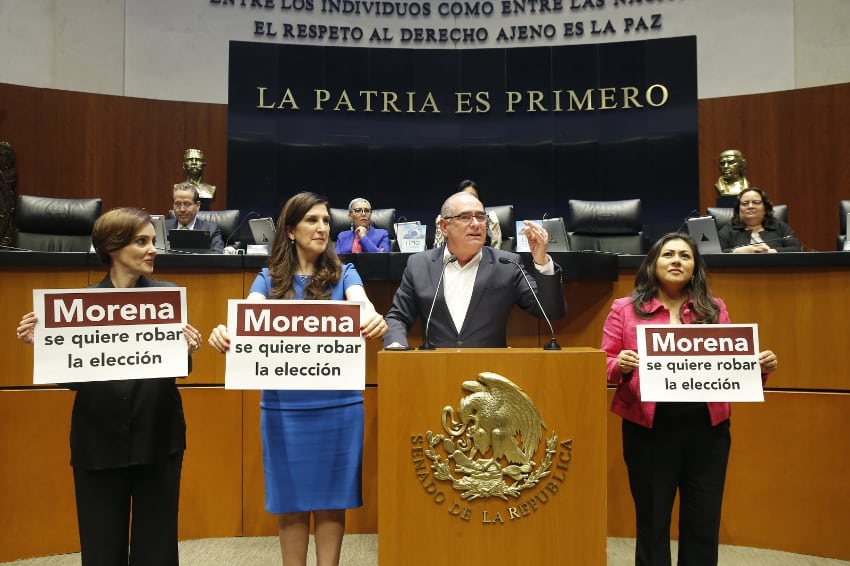
The reform will slash INE’s budget and therefore force the dismissal of staff, diminish its capacity to sanction politicians who violate electoral laws, curtail its autonomy and close some INE offices, among other consequences
Seventy-two senators with the ruling Morena party and its allies voted in favor of the legislation, which was put forward after a more ambitious constitutional bill to overhaul Mexico’s electoral system was blocked late last year, while 50 opposition lawmakers opposed it. The reform modifies secondary laws rather than the constitution and consequently only required a simple majority to pass Congress.
“What the government is proposing is the destruction of INE,” said National Action Party (PAN) Senator Lilly Téllez. She accused Morena lawmakers of “selling the homeland” and claimed that López Obrador’s aim is to “cheat” in upcoming elections, including the 2024 presidential election.
Many opposition lawmakers indicated they would challenge the reform in the Supreme Court, a likelihood López Obrador acknowledged at his regular news conference on Thursday morning.
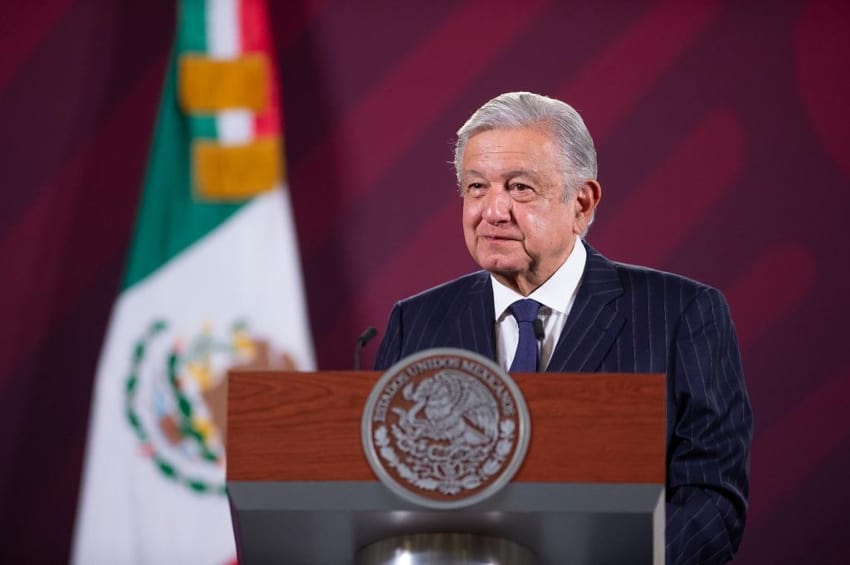
“We’re going for Plan C – that of the citizens,” said PAN Senator Alfredo Botello in reference to the proposed legal action.
The Supreme Court has already ruled that modifications to the Social Communication Law and the General Administrative Responsibility Law that were included in a separate “Plan B” reform package that was approved last year won’t apply in the lead-up to state elections in Coahuila and México state this year. A veda electoral – a period of pre-election silence that prevents politicians including the president from campaigning – will consequently remain in place before the two gubernatorial elections.
Much of the debate prior to Wednesday’s vote focused on a clause backed by Morena’s allies that would have allowed major parties to transfer votes to their smaller coalition partners to avoid their possible deregistration. Parties are deregistered if they fail to attract a minimal level of support from voters at elections.
The so-called “political parties’ eternal life” clause was excluded from the reform package before Wednesday’s vote in the Senate, but it is set to be reconsidered at a later date.
INE said on its official Twitter account that the “Plan B” reform passed on Wednesday “would place equity and transparency at risk” in upcoming elections because political parties and candidates won’t be required to report pre-campaign income and expenses.
It said last month that approval of the reform would force the dismissal of almost 6,000 employees, a figure equivalent to about one-third of the INE workforce.
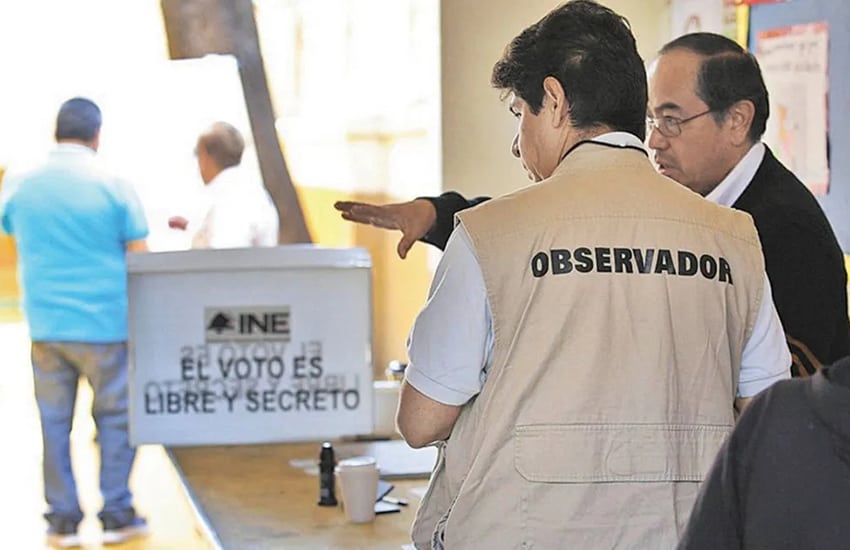
Luis Carlos Ugalde, president of the Federal Electoral Institute (the forerunner to the INE) from 2003 to 2007, said last week that the capacity of the electoral institute to organize elections would be adversely affected by the approval of the reform. He raised concerns about the capacity of a diminished INE to install 160,000 voting booths for the 2024 election and count votes in an accurate and timely fashion.
The current INE president has voiced similar concerns himself.
“One would think that in an environment where Morena is in government and has more probability of winning [in 2024] … that it would sow conditions to provide certainty, tranquility and a level playing field, Ugalde said.
Polls show that López Obrador retains the support of a majority of Mexicans more than four years into his presidency and that Morena’s candidate at the 2024 election – most likely Mexico City Mayor Claudia Sheinbaum or Foreign Affairs Minister Marcelo Ebrard – will become Mexico’s next president.
Opposition lawmakers lined up on Wednesday to denounce the electoral reform and excoriate Morena for ensuring its passage through Congress.
Institutional Revolutionary Party (PRI) Senator Claudia Ruiz Massieu accused the ruling party of using its congressional majority to “blow up the foundations” of democracy in Mexico.
“They’re not seeking to improve the system but … to have unfair advantages,” she said.
“… The opposition is going to the Supreme Court to challenge this backward step … and we’re also taking to the streets,” Massieu said, acknowledging protests set to take place in cities across the country this Sunday.
“I’m going to march this Sunday because I’m going to defend democracy,” said PAN Senator Xóchitl Gálvez.
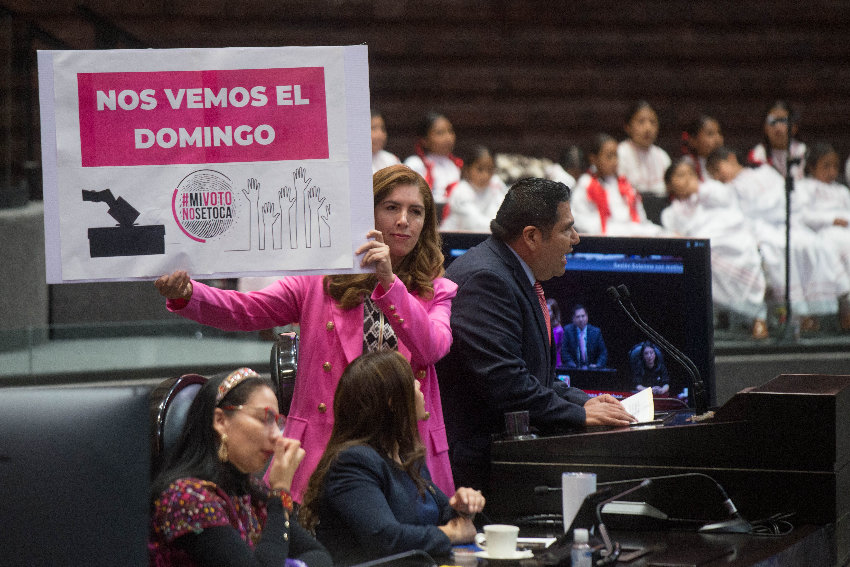
“… [They say] they want to save money, but why don’t they complain about the embezzlement that’s happening at [the] Dos Bocas [oil refinery],” she said in an apparent reference to a sharp increase in construction costs.
PAN Senator Damián Zepeda asserted that the reform “mutilates” the INE, leaving it “incapable of carrying out its work.”
For his part, independent Senator Emilio Álvarez Icaza described the reform as the “most regressive” legislation of the past 30 years.
“[Morena] wants to maintain power illegitimately and illegally. They want to put their hands in the ballot box and change the will of the people,” he said.
PAN senators held up signs in the upper house that asserted that “Morena wants to steal the [2024] election.”
López Obrador has rejected claims that the reform places the staging of free and fair elections at risk while touting 3.5 billion pesos (US $190.5 million) in annual savings it will generate – money he would prefer to spend on government welfare and infrastructure programs.
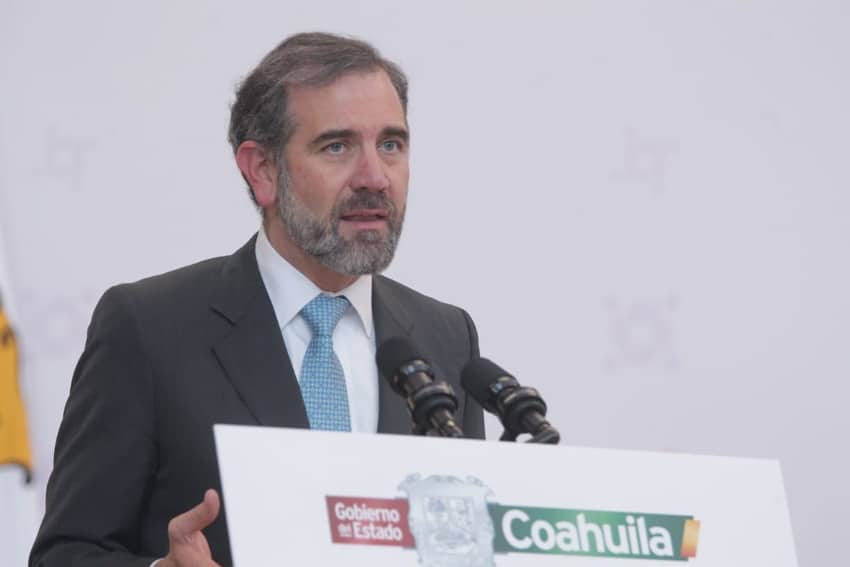
Córdova, the INE chief, said Thursday that payouts to employees of the same amount will be required due to the dismissals necessitated by the reform. He said last month that the “Plan B” reform would “blow up the elections” and called on citizens to present “all legal resources within their reach to stop” it.
Córdova, whose eight-year term as INE president ends in April, said Thursday that “it’s better to go to the elections in 2024 with the rules that have given us political stability and not play the sorcerer’s apprentice with a collection of norms that reinvent the electoral system.”
Established in 1990, the Federal Electoral Institute oversaw Mexico’s transition to full democracy after the country was ruled uninterruptedly by the PRI for over 70 years until the PAN triumphed at the 2000 presidential election.
Poll results published by the Reforma newspaper last November showed that 80% of respondents believe that the INE has played an important role in guaranteeing democracy in Mexico while 71% said that its demise would pose a threat to democracy.
López Obrador blames the institute for his narrow loss at the 2006 presidential election, accusing it of perpetrating electoral fraud. He led mass protests against the official result and had himself sworn in as Mexico’s “legitimate president” in an event held in the Zócalo, Mexico City’s central square.
López Obrador said in late January that Córdova was a “public servant without principles or ideals” and “a fraud.”
The president also charged that the INE has been taken over by “conservatives” and that he won the 2018 election “despite them.”
He predicted Thursday that his “Plan B” reform would survive legal challenges because nothing in it is “outside the law.”
With reports from El País, Animal Político, Expansión
Recent Comments